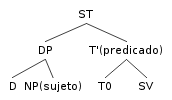Endocentric construction
The endocentric construction is a compound syntactic constituent that consists of a nucleus, which is an indispensable element, and other dispensable elements that complement the nucleus. Verb phrases are clearly endocentric constructions, since they always contain a lexical verb inside. For example, in the expression “the green bird [[perched] on the branch of the tree]”, the head “perched” could dispense with the other two elements that accompany it in the verb phrase such as «on the tree branch» without giving rise to any anomalous expression.
Endocentric hypothesis
In the beginnings of syntactic theory it was thought that some phrases could be exocentric (non-endocentric) without any element acting as a nucleus. For example, a sentence according to the traditional analysis seemed like a phrase in which there seemed to be no nucleus:
- (1a) Juan came and left
- (1b) Ø wine and left (subject submission)
- (2a) Juan came and also came Pedro
- (2b) Juan came and also Ø Pedro (verb omission)
That is why in the traditional analysis it was considered reasonable to postulate that a sentence was an exocentric phrase of structure:
However, some modern approaches accept the generalized endocentricity hypothesis conjecturing that all phrases actually have a nucleus that shares certain properties of syntactic behavior with the full phrase. In fact, a sentence in the generativist analysis is considered a maximum projection or time phrase associated with the nucleus of temporal inflection, so the generally accepted structure to explain certain facts is:
Where the subject is formed by a determiner phrase and the nucleus T0 can be occupied by an auxiliary or by a finite verb that "moves" to the position of the nucleus T0.
Contenido relacionado
Chaos (disambiguation)
Zaparoan languages
Austronesian languages

